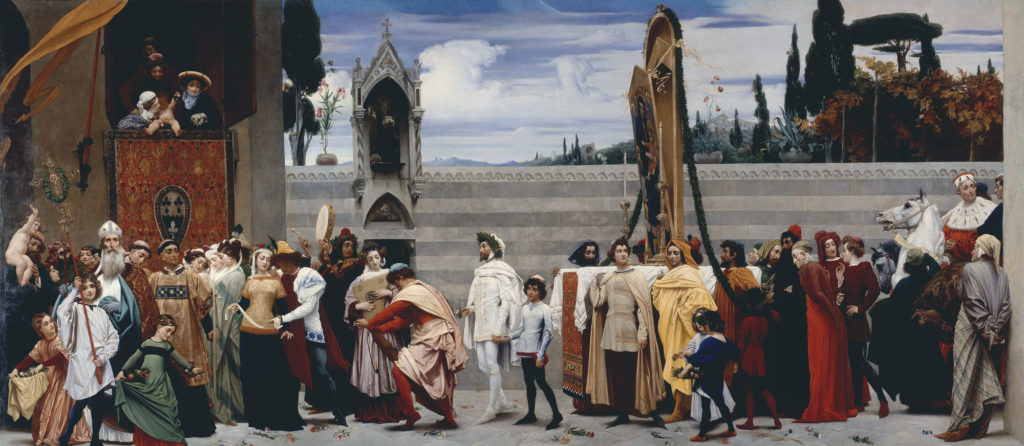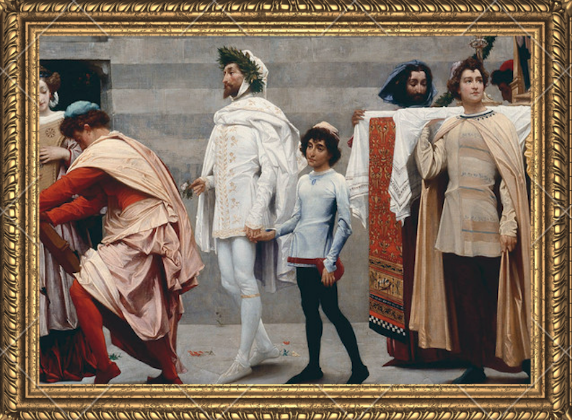Introduction
“There was a very big picture by a man called Leighton, his 1st attempt, at the age of 20… It is a beautiful painting, quite reminding one of a Paul Veronese, so bright and full of light. Albert was enchanted with it – so much so that he made me buy it. The young man’s father said that his future career in life would depend on the success of this picture.”[1]
-Queen Victoria in a journal entry, 1855
Frederic Leighton’s 1855 painting Cimabue’s Celebrated Madonna is Carried in Procession through the Streets of Florence (Figure 1) depicts a lively ceremony in which a large altar, featuring an altarpiece with the Madonna and Child, is transported through the streets of Florence to the church of Santa Maria Novella. The subject of this panoramic work comes from Giorgio Vasari’s Lives of the Artists (1550), which was translated into English in 1850-1.[2] Leighton modeled the painting-within-the-painting after the well-known Rucellai Madonna (Figure 2)—a work then believed to be the work of Cimabue, but subsequently attributed to Sienese painter Duccio di Buoninsegna. The work was painted at an early moment in Leighton’s career, while traveling in Florence, Venice and Rome between 1852-1854 to study the great works of the Italian Renaissance.[3] Nevertheless, the painting was intended for a specifically British viewership, and presented a clearly constructed version of the Renaissance as Leighton and the Victorians saw it.

Figure 1. Frederic Leighton, Cimabue’s Celebrated Madonna, 1853-5, oil on canvas, 87 x 205 in, National Gallery, London.
Although the subject matter of Cimabue’s Celebrated Madonna was old, it was created just a couple of years after the English translation of Vasari’s Lives, making it “ripped from the headlines” for the British viewing public. Indeed, by rendering this Vasarian anecdote in the style of Venetian narrative painting, Leighton responded directly to vibrant contemporary debates about the Renaissance and its relevance for Victorian art and society.
Of particular importance to Leighton’s vision of the Renaissance was John Ruskin’s 1851 text Stones of Venice. In this text, Ruskin compared the “essential nobleness” of Gothic art and architecture with the paganism and lasciviousness of the Renaissance, and stated that “all great European art is rooted in the thirteenth century.”[4] Cimabue’s Celebrated Madonna drew praise from Ruskin due to its embodiment of principles of painting that Ruskin applauded in The Stones of Venice, such as “Venetian simplicity,” careful construction, exquisite detail, vibrant treatment of color, reliance on truthful representation, and elegant finish.[5] One of Ruskin’s most salient claims was that contemporary artists who emulated the style of Venetian and Gothic art could thereby regenerate society according to more ethical principles. Leighton intentionally incorporated several of the elements that Ruskin called for in The Stones of Venice in Cimabue’s Celebrated Madonna: the painting constitutes a vibrant image of Ruskin’s values and a bid to match the merits of Renaissance art.
In 1855, the painting was shown at the Royal Academy exhibition, receiving positive reviews for its reliance on Italian painting principles and especially its emulation of Venetian works, and was purchased by Queen Victoria. The popular British journal Athenaeum commented on the painting following its public display, saying “One of the finest pictures in the Exhibition—painted in the true, as distinguished from the modern, Pre-Raphaelite style,” and commented that “no picture in the Exhibition attracts more interest than the Procession of Cimabue.“[6] The article went on to say that
“There can be no question that the picture is one of great power, although the composition is quaint even to sectarianism; and though the touch, in parts broad and masterly, is in the lesser parts of the roughest character.”[7]

Figure 2. Duccio di Buoninsegna, Rucellai Madonna, 1285, tempera and gold on panel, 180 x 110 in, Uffizi Gallery, Florence.
Later in the review, the Athenæum commented on the “preserved” Italian art history seen in Leighton’s painting, the grandeur of the arrangement of figures and architectural elements. Another source, the Art Journal, commented that there “had been no production of modern times more entirely excellent than this…it is faithful to a high purpose: the conception is worthy of the theme, and that theme is of the loftiest, for it elevates and honors and perpetuates the glory of the artist and the Art.”[8] As is clear in these remarks, Victorian critics saw in Cimabue’s Celebrated Madonna the reincarnation of the great tradition of Renaissance art.
The author of the Athenæum review also remarked upon the effect of Queen Victoria’s well-publicized purchase of Cimabue’s Celebrated Madonna on British viewers: “Amateurs who only admire admired pictures, and critics who are ill to please, disarmed by the Queen’s purchase of the picture, stop and gaze and smile where they might, perhaps, have sneered or frowned.” As this comment suggests, Victoria’s tastes impacted those of the British public; she, in turn, was sensitive to public perceptions of her artistic patronage. In the journal passage cited above, her comparison of the painting to the work of Venetian painter Paolo Veronese makes clear her knowledge of Renaissance art, and may even suggest her familiarity with Ruskin’s text. Her acquisition of the work, keyed to current intellectual and artistic debates about the Renaissance, established the royal couple as knowledgeable, cultured tastemakers. This was an important move in the wake of the 1848 revolutions that swept across Europe. While Victoria was one of few monarchs to remain in power, the continuing threat of instability both in Britain and its colonies during the early 1850s served as a constant reminder of the tenuousness of her hold on the throne. The purchase of Leighton’s painting was one of many symbolic moves she made to strengthen her central position in the British political and cultural sphere. For Victoria, the purchase would have proved that she was learned, enlightened, and in touch with the sophisticated values of the Italian past.
By relating Cimabue’s Celebrated Madonna to Victorian debates about the Renaissance, this capstone sheds new light on Leighton’s art and the relationship of art to politics in the early Victorian era. Though Leighton was a celebrated artist in his own time, and garnered considerable institutional authority as President of the Royal Academy from 1878 to 1896, his lifelong adherence to an academic, narrative tradition of painting led subsequent scholars to see his work as representative of the “backwardness” of British painting.[9] As Stephen Jones notes in Frederic, Lord Leighton, “Leighton is invariably cited in studies of 19th century British art as the archetypal academic artist. This judgment, in which the implication of the adjective ‘academic’ is most often implicitly pejorative, is so universally stated and accepted as to invite no qualification.”[10] His work and reputation coincide with a longstanding perception that Victorian art was kitschy, commercial, and anti-modern; as Richard Ormond states, “He has been considered as the heir to a dead tradition, and whose pictures are arid and lifeless.”[11] Ormond’s monograph, published in 1970, provided an initial reevaluation of Leighton’s work upon which subsequent scholars would build.
With their 1999 monograph Frederic Leighton: Antiquity, Renaissance, Modernity, Tim Barringer and Elizabeth Prettejohn sought to further contest Leighton’s marginalization from the history of modern art. Rather than positioning Leighton as a banal academic painter, the authors show his active, thoughtful engagement with the art of the past as well as the concerns of the present day. First, they analyze Leighton’s appropriation of the ancient world to argue that he was aware of contemporaneous scientific and archaeological developments, saw classical art as a model of ‘abstract form,’ and attempted to bring to life to classical statuary.[12] Next, they focus on Leighton’s lifelong investment in the Renaissance; for Barringer and Prettejohn, Cimabue’s Celebrated Madonna was an attempt to reinvigorate history painting.[13] The authors devote the third section to Leighton’s engagement with his own time, showing that Leighton engaged deeply with contemporary issues such as the nuances of the developing international art world, arising importance of public image and self-presentation, and institutional reform within the Royal Academy. They also portray him as an active member of the public sphere, in his role as President of the Royal Academy.[14] Unlike the contemporary Pre-Raphaelites, Leighton was not interested in referencing the past as a way of escapism from modernity; he was reenergizing the past through emulation.[15] The authors also discuss attacks on Leighton’s work, both in its own time and afterward, for its perceived elitism, flamboyance, and effeminacy—attacks that led to his exclusion from traditional accounts of modernism.
Building on the work of Barringer and Prettejohn, Keren Hammerschlag’s Frederic Leighton: Death, Morality, Resurrection further situates Leighton in the context of Victorian society and visual culture. Focusing specifically on resonances between Leighton’s art and current debates about death, theology, morbidity, archaeology, and medicine, Hammerschlag considers the interplay between Leighton’s practice and his broader historical context. Aligning Leighton’s work with tropes tied to the Gothic, such as the dead, demons and the occult, she frames Leighton’s art around John Ruskin’s description of Leighton as a “kindred Goth,” attuned to the great principles of Gothic art and architecture.[16]An example of the Gothic she provides is Leighton’s treatment of figures, how they often hover between a state of life and death.[17] In her analysis of Cimabue’s Celebrated Madonna, Hammerschlag argues that the work represents the symbolic death of medievalism. With a composition that mirrors the form of Victorian funeral processions, she claims, the depicted scene marks a transitional state between the Middle Ages and the Renaissance, between the death of the old world, and the emergence of the new.
This capstone adds to the recent reevaluation of Leighton’s art and its relationship to the Victorian intellectual, artistic, and political context by analyzing Cimabue’s Celebrated Madonna from the perspective of both the artist and patron. In section one, I focus on the painting itself, putting its emulation of Venetian painting principles into the context of Leighton’s career. Section two frames the painting within broader debates about Italy and the Renaissance, showing how Leighton’s painting was relevant and responsive to the Victorian art world. Finally, section three analyzes the significance of the painting’s purchase for Victoria and Albert at a moment of political and social instability at home and abroad; the purchase helped the royals to elevate their status as modern leaders in touch with current cultural and intellectual trends. By explicating these aspects of Cimabue’s Celebrated Madonna, I seek to further substantiate the emerging view of Leighton as a definitively modern artist.
